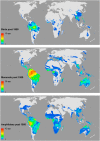Global patterns of terrestrial vertebrate diversity and conservation
- PMID: 23803854
- PMCID: PMC3710798
- DOI: 10.1073/pnas.1302251110
Global patterns of terrestrial vertebrate diversity and conservation
Abstract
Identifying priority areas for biodiversity is essential for directing conservation resources. Fundamentally, we must know where individual species live, which ones are vulnerable, where human actions threaten them, and their levels of protection. As conservation knowledge and threats change, we must reevaluate priorities. We mapped priority areas for vertebrates using newly updated data on >21,000 species of mammals, amphibians, and birds. For each taxon, we identified centers of richness for all species, small-ranged species, and threatened species listed with the International Union for the Conservation of Nature. Importantly, all analyses were at a spatial grain of 10 × 10 km, 100 times finer than previous assessments. This fine scale is a significant methodological improvement, because it brings mapping to scales comparable with regional decisions on where to place protected areas. We also mapped recent species discoveries, because they suggest where as-yet-unknown species might be living. To assess the protection of the priority areas, we calculated the percentage of priority areas within protected areas using the latest data from the World Database of Protected Areas, providing a snapshot of how well the planet's protected area system encompasses vertebrate biodiversity. Although the priority areas do have more protection than the global average, the level of protection still is insufficient given the importance of these areas for preventing vertebrate extinctions. We also found substantial differences between our identified vertebrate priorities and the leading map of global conservation priorities, the biodiversity hotspots. Our findings suggest a need to reassess the global allocation of conservation resources to reflect today's improved knowledge of biodiversity and conservation.
Keywords: biogeography; conservation planning; endemism; species distributions.
Conflict of interest statement
The authors declare no conflict of interest.
Figures





References
-
- Pimm SL, Jenkins C. Sustaining the variety of life. Sci Am. 2005;293(3):66–73. - PubMed
-
- Manne LL, Brooks TM, Pimm SL. Relative risk of extinction of passerine birds on continents and islands. Nature. 1999;399(6733):258–261.
-
- Myers N, Mittermeier RA, Mittermeier CG, da Fonseca GA, Kent J. Biodiversity hotspots for conservation priorities. Nature. 2000;403(6772):853–858. - PubMed
-
- Myers N. The biodiversity challenge: Expanded hot-spots analysis. Environmentalist. 1990;10(4):243–256. - PubMed
Publication types
MeSH terms
LinkOut - more resources
Full Text Sources
Other Literature Sources
Molecular Biology Databases
Research Materials

